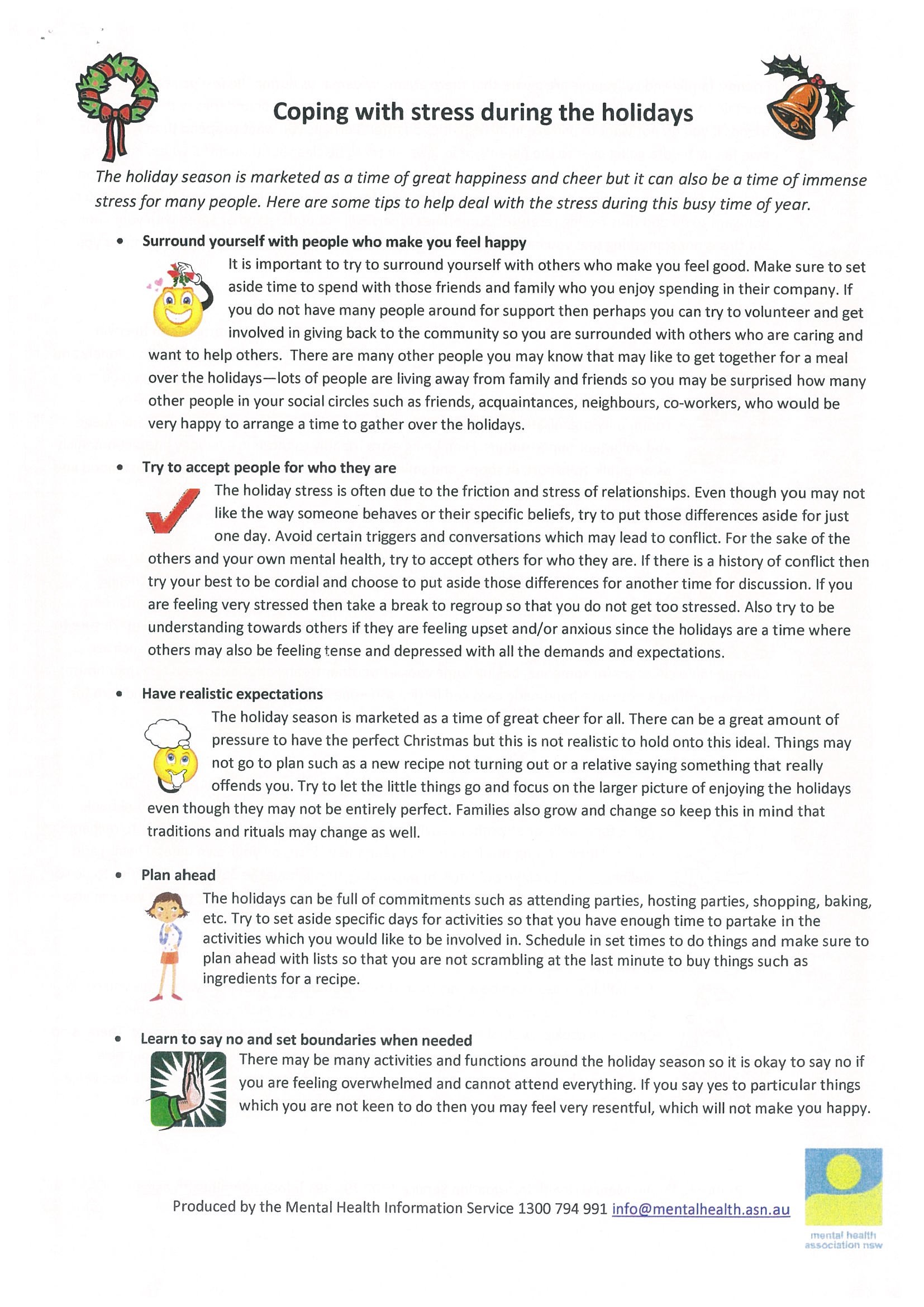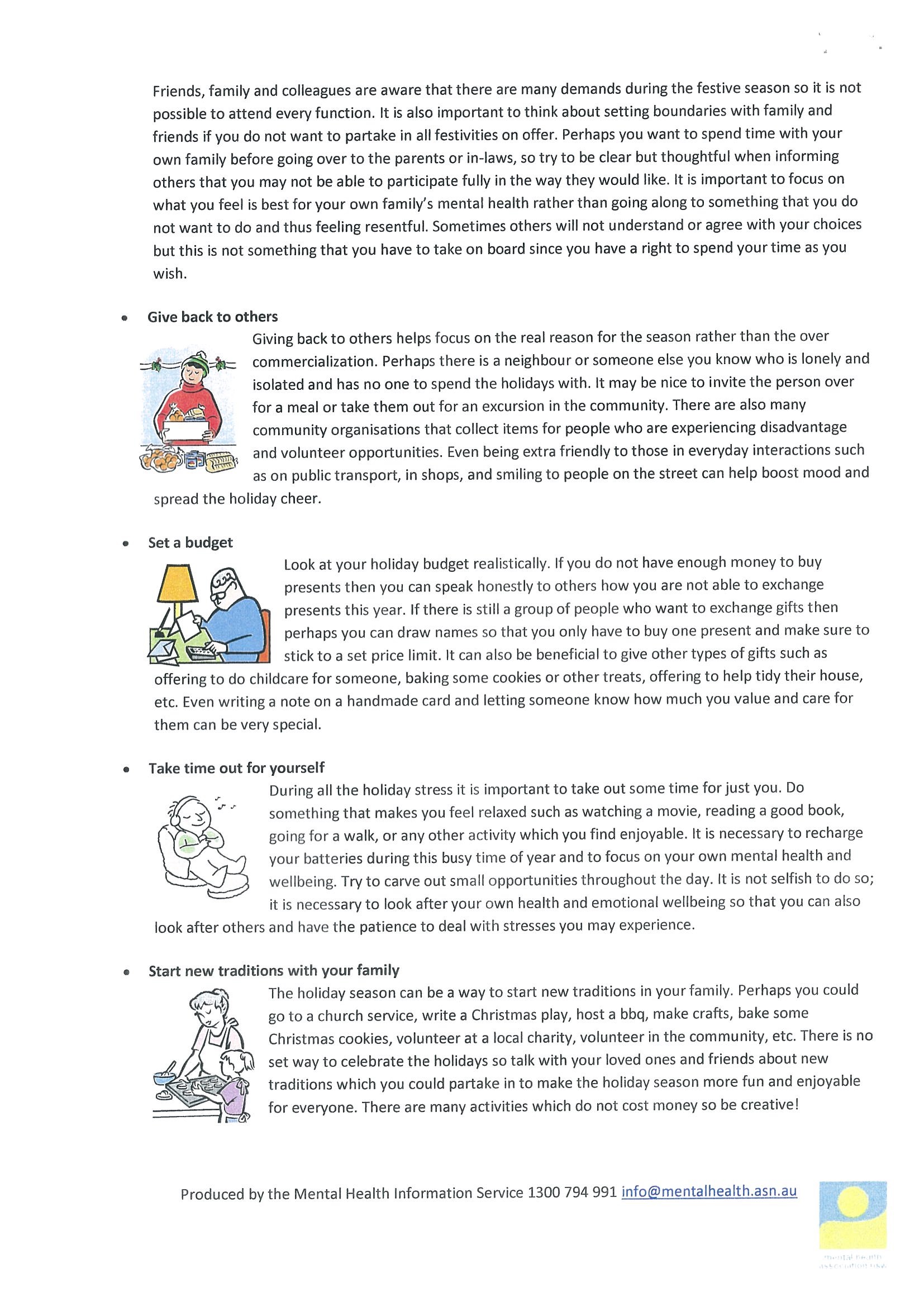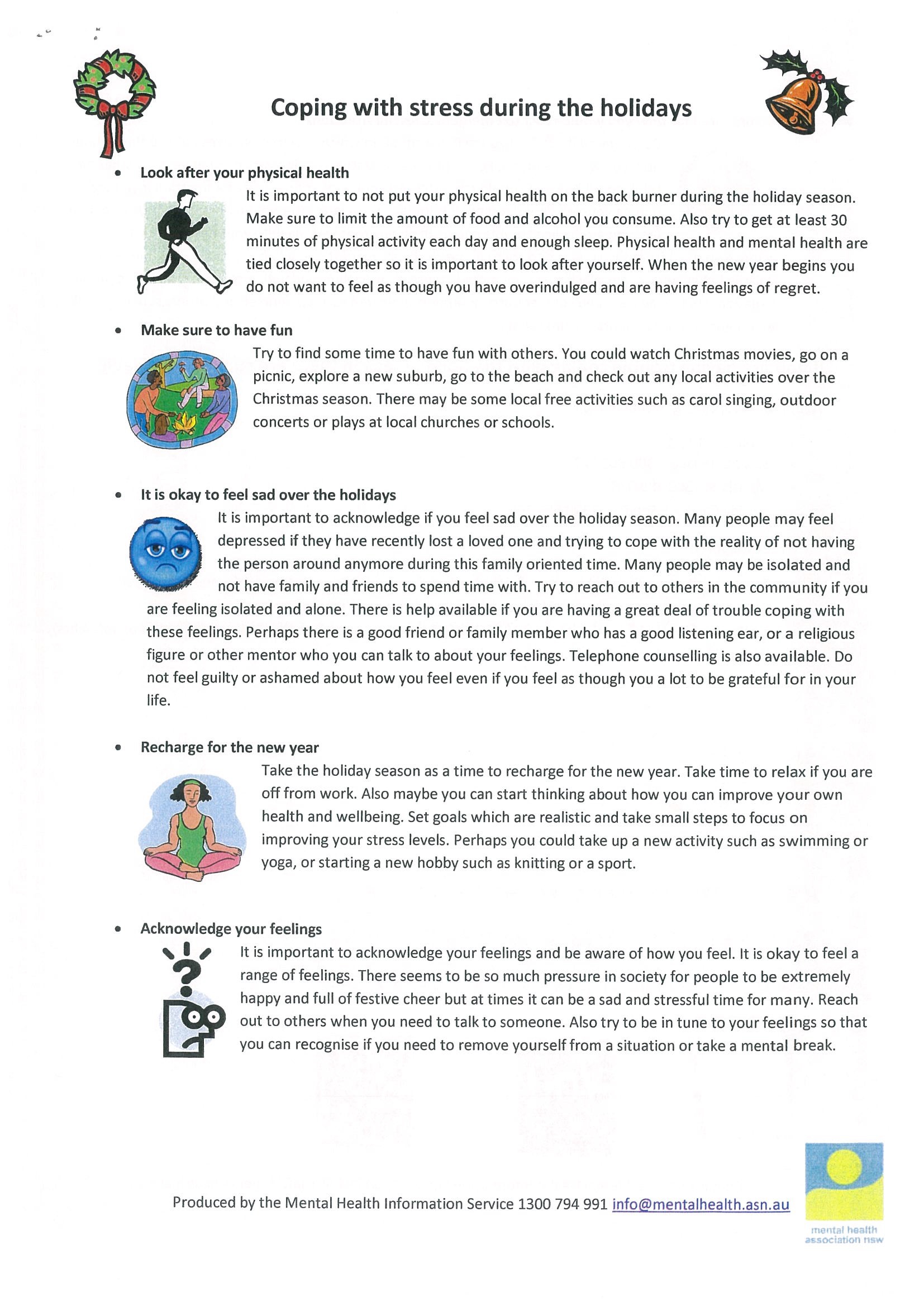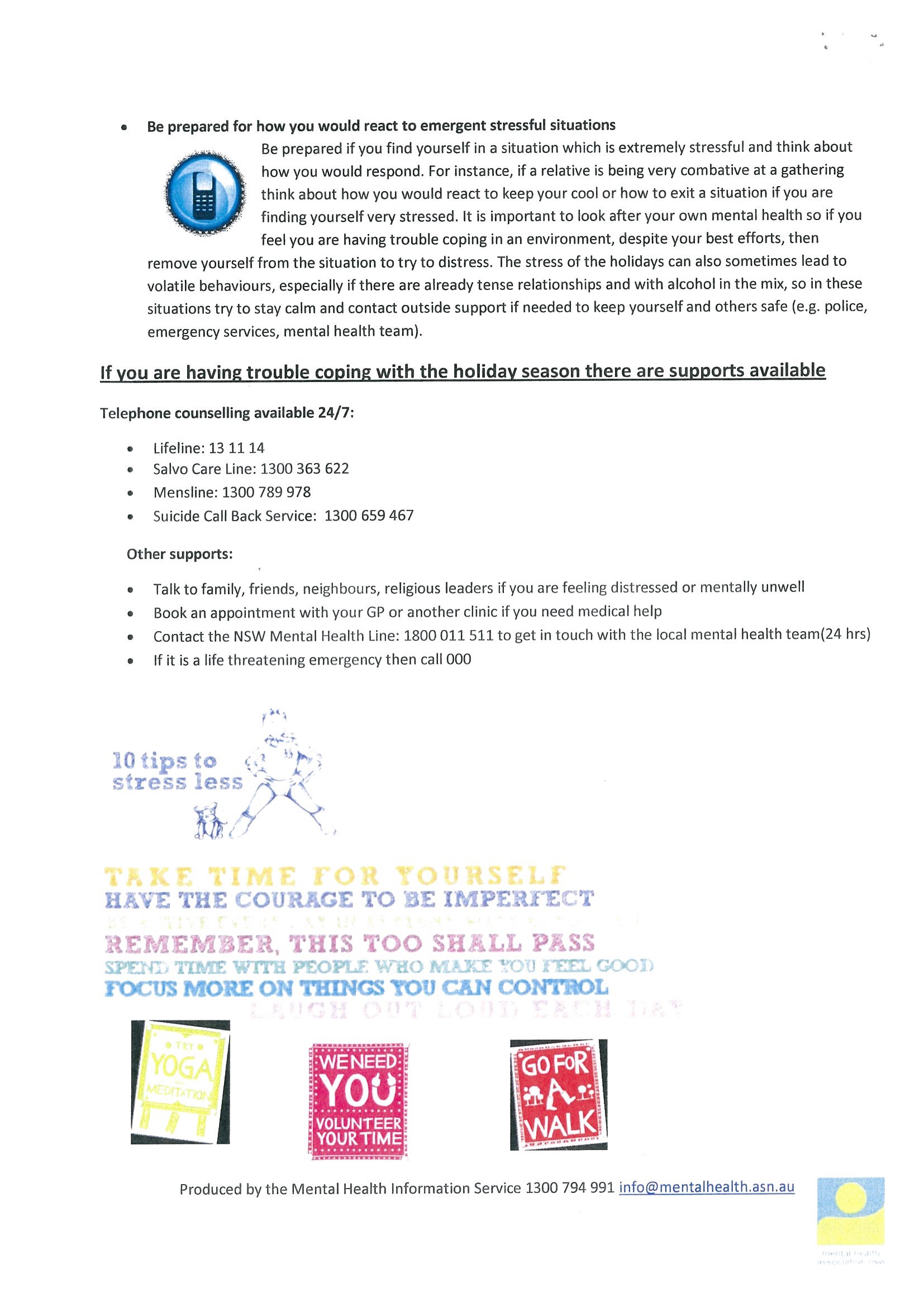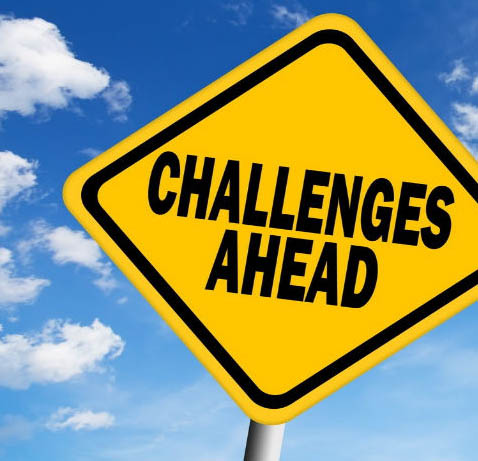Administrator
Coping with stress during the holidays
PTSD Treatment for Veterans: What’s Working, What’s New, and What’s Next

More than a decade of war in the Middle East has pushed post-traumatic stress disorder (PTSD) to the forefront of public health concerns. The last several years have seen a dramatic increase in the number of Iraq and Afghanistan war veterans seeking help for PTSD, shining a spotlight on this debilitating condition and raising critical questions about appropriate treatment options and barriers to care.
While PTSD extends far beyond the military—affecting about eight million American adults in a given year—the problem is especially acute among war veterans. Not only are recent veterans at higher risk of suffering from PTSD than those in the general population, they also face unique barriers to accessing adequate treatment. These include the requirement that they have either an honorable or general discharge to access Department of Veterans Affairs (VA) medical benefits, long waiting lists at VA medical centers, and the social stigma associated with mental illness within military communities. According to a study conducted by the RAND Center for Military Health Policy Research, less than half of returning veterans needing mental health services receive any treatment at all, and of those receiving treatment for PTSD and major depression, less than one-third are receiving evidence-based care.
PTSD in Combat Veterans
The existence of war-induced psychological trauma likely goes back as far as warfare itself, with one of its first mentions by the Greek historian Herodotus. In writing about the Battle of Marathon in 490 b.c., Herodotus described an Athenian warrior who went permanently blind when the soldier standing next to him was killed, although the blinded soldier himself had not been wounded. Such accounts of psychological symptoms following military trauma are featured in the literature of many early cultures, and it is theorized that ancient soldiers experienced the stresses of war in much the same way as their modern-day counterparts.
The symptoms and syndrome of PTSD became increasingly evident during the American Civil War (1861–1865). Often referred to as the country’s bloodiest conflict, the Civil War saw the first widespread use of rapid-fire rifles, telescopic sights, and other innovations in weaponry that greatly increased destructiveness in battle and left those who survived with a myriad of physical and psychological injuries.
The Civil War also marked the start of formal medical attempts to address the psychological effects of combat on military veterans. Jacob Mendez Da Costa (1833–1900), a cardiologist and assistant surgeon in the U.S. Army, undertook research on “irritable heart” (neurocirculatory asthenia) in soldiers, and during the Civil War, this PTSD-like disorder was referred to as “Da Costa’s syndrome.” Da Costa reported in the American Journal of Medical Science that the disorder, marked by shortness of breath, rapid pulse, and fatigue, is most commonly observed in soldiers during times of stress, especially when fear is involved.
Over the next century of American warfare, PTSD would be described by many different names and diagnoses, including “shell shock” (World War I), “battle fatigue” (World War II), and “post-Vietnam syndrome.” An estimated 700,000 Vietnam veterans—almost 25% of those who served in the war—have required some form of psychological care for the delayed effects of combat exposure. The diagnosis of PTSD was not adopted until the late 1970s, and it became official in 1980 with inclusion in the third edition of the Diagnostic and Statistical Manual of Mental Disorders
Prevalence of PTSD in Veterans
Estimates of PTSD prevalence rates among returning service members vary widely across wars and eras. In one major study of 60,000 Iraq and Afghanistan veterans, 13.5% of deployed and nondeployed veterans screened positive for PTSD, while other studies show the rate to be as high as 20% to 30%. As many as 500,000 U.S. troops who served in these wars over the past 13 years have been diagnosed with PTSD.
It is not clear if PTSD is more common in Iraq and Afghanistan veterans than in those of previous conflicts, but the current wars present a unique set of circumstances that contribute heavily to mental health problems. According to Paula P. Schnurr, PhD, Executive Director of the VA National Center for PTSD, the urban-style warfare tactics in Afghanistan and Iraq, marked by guerrilla attacks, roadside improvised explosive devices, and the uncertain distinction between safe zones and battle zones, may trigger more post-traumatic stress in surviving military members than conventional fighting.
In addition, Dr. Schnurr notes, improvements in protective gear and battlefield medicine have greatly increased survivability—but at a high price. “Between the way we’re protecting the troops and responding to injuries on the ground, a lot of soldiers are surviving with very significant injuries who would not necessarily have survived before,” she says. “And they’re returning stateside with both the physical and psychological trauma.”
Comorbidity of PTSD in Veterans
Complicating the diagnosis and assessment of PTSD in military veterans are the high rates of psychiatric comorbidity. Depression is the most common comorbidity of PTSD in veterans. Results from a large national survey show that major depressive disorder (MDD) is nearly three to five times more likely to emerge in those with PTSD than those without PTSD. A large meta-analysis composed of 57 studies, across both military and civilian samples, found an MDD and PTSD comorbidity rate of 52%.
Other common psychiatric comorbidities of PTSD in military veterans include anxiety and substance abuse or dependence. The National Vietnam Veterans Readjustment Study, conducted in the 1980s, found that 74% of Vietnam veterans with PTSD had a comorbid substance use disorder (SUD). In one study of recent veterans, 63% of those who met the diagnostic criteria for alcohol use disorders (AUDs) or drug use disorders had co-occurring PTSD, while the PTSD prevalence among those who met criteria for both AUDs and drug use disorders (e.g., alcohol dependence and cocaine abuse) was 76%.
Studies also suggest that veterans with comorbid PTSD and SUD are more difficult and costly to treat than those with either disorder alone because of poorer social functioning, higher rates of suicide attempts, worse treatment adherence, and less improvement during treatment than those without comorbid PTSD.
PTSD is associated with physical pain symptoms, as well. For veterans returning from Iraq and Afghanistan, chronic pain continues to be one of the most frequently reported symptoms. Approximately 15% to 35% of patients with chronic pain also have PTSD.
Risk Factors for PTSD in Veterans
A number of factors have been shown to increase the risk of PTSD in the veteran population, including (in some studies) younger age at the time of the trauma, racial minority status, lower socioeconomic status, lower military rank, lower education, higher number of deployments, longer deployments, prior psychological problems, and lack of social support from family, friends, and community (Table 1). PTSD is also strongly associated with generalized physical and cognitive health symptoms attributed to mild traumatic brain injury (concussion).
Table 1
Significant Risk Factors for Combat-Related PTSD in Military Personnel and Veterans
| Factors | Odds Ratio (95% CI) |
|---|---|
| Pretraumatic Factors | |
| Female gender | 1.63 (1.32–2.01) |
| Nonwhite race | 1.18 (1.06–1.31) |
| Lower education level | 1.33 (1.14– 1.54) |
| Lower rank (nonofficer) | 2.18 (1.84–2.57) |
| Army as branch of service | 2.30 (1.76–3.02) |
| Combat specialization | 1.69 (1.39–2.06) |
| Number of deployments (≥ 2) | 1.24 (1.10–1.39) |
| Longer length of deployments | 1.28 (1.13–1.45) |
| Adverse life events | 1.99 (1.55–2.57) |
| Prior trauma | 1.13 (1.01–1.26) |
| Psychological problem(s) | 1.49 (1.22–1.82) |
| Peritrauma Factors | |
| Combat exposure | 2.10 (1.73–2.54) |
| Discharged a weapon | 4.32 (2.60–7.18) |
| Saw someone wounded/killed | 3.12 (2.40–4.06) |
| Severe trauma | 2.91 (1.85–4.56) |
| Deployment-related stressor | 2.69 (1.46–4.96) |
| Post-Trauma Factors | |
| Postdeployment support (yes) | 0.37 (0.18–0.77) |
CI = confidence interval; PTSD = post-traumatic stress disorder.
Female gender has also been implicated as a potential risk factor for PTSD in veterans. A number of factors may account for these findings, including a history of military or civilian sexual assault, which may increase a woman’s risk for PTSD. According to one study, during 2002–2003, approximately 22% of screened female veterans reported military sexual trauma (MST), a term adopted by the VA to refer to sexual assault or repeated threatening sexual harassment that occurred while the veteran was in the military.
Despite numerous studies, according to Dr. Schnurr, whether PTSD is a greater risk to female veterans than male veterans is still largely unknown. However, she says that as women continue to play more active roles in the wars in Iraq and Afghanistan and are increasingly exposed to combat situations, their likelihood of experiencing PTSD rises.
More research is needed to better understand these and other risk factors for PTSD and to help clinicians and other care providers offer the necessary treatment before symptoms become chronic. Several large VA studies are under way that include both psychological and neurobiological measurement, Dr. Schnurr says. She notes the benefit of studying the effects of war-related acute stress in real time, using both pre- and post-deployment assessments, as well as data from military members currently in theater. “These wars have given us the best opportunity to longitudinally track what happens to people and to examine the risk and resilience factors associated with the outcomes,” she adds.
Defining and Redefining PTSD
The VA defines PTSD as “the development of characteristic and persistent symptoms along with difficulty functioning after exposure to a life-threatening experience or to an event that either involves a threat to life or serious injury.” In addition to military combat, PTSD can result from the experience or witnessing of a terrorist attack, violent crime and abuse, natural disasters, serious accidents, or violent personal assaults.
In 2013, the American Psychiatric Association revised the PTSD diagnostic criteria in the fifth edition of its Diagnostic and Statistical Manual of Mental Disorders (DSM-5), moving PTSD from the class of “anxiety disorders” into a new class of “trauma and stressor-related disorders.” As such, all of the conditions included in this classification require exposure to a traumatic or stressful event as a diagnostic criterion. DSM-5 categorizes the symptoms that accompany PTSD into four “clusters”:
-
Intrusion—spontaneous memories of the traumatic event, recurrent dreams related to it, flashbacks, or other intense or prolonged psychological distress
-
Avoidance—distressing memories, thoughts, feelings, or external reminders of the event
-
Negative cognitions and mood—myriad feelings including a distorted sense of blame of self or others, persistent negative emotions (e.g., fear, guilt, shame), feelings of detachment or alienation, and constricted affect (e.g., inability to experience positive emotions)
-
Arousal—aggressive, reckless, or self-destructive behavior; sleep disturbances; hypervigilance or related problems.
PTSD can be either acute or chronic. The symptoms of acute PTSD last for at least one month but less than three months after the traumatic event. In chronic PTSD, symptoms last for more than three months after exposure to trauma.
PTSD Diagnosis and Assessment
Two main types of measures are used to help diagnose PTSD in veteran populations and assess its severity: structured interviews and self-report questionnaires. The Clinician-Administered PTSD Scale for DSM-5 (CAPS-5) is considered the gold standard for PTSD assessment in both veterans and civilians. The detailed 30-item interview has proven useful across a wide variety of settings and takes approximately 30 to 60 minutes to administer.
The well-validated PTSD Checklist for DSM-5 (PCL-5) is one of the most commonly used self-report measures of PTSD. Administration of the 20-item questionnaire is required by the VA for veterans being treated for PTSD as part of a national effort to establish PTSD outcome measures. The PCL-5 can be completed in five to seven minutes.
Another widely used self-report measure for veterans is the Mississippi Scale for Combat-Related PTSD, a 35-item questionnaire in which respondents are asked to rate how they feel about each item using a five-point Likert scale (e.g., “Before I entered the military, I had more close friends than I have now.” [1 = not at all true to 5 = extremely true]).
Nonpharmacological Treatment Of PTSD in Veterans
The use of psychological interventions is regarded as a first-line approach for PTSD by a range of authoritative sources. Of the wide variety of psychotherapies available, cognitive behavioral therapy (CBT) is considered to have the strongest evidence for reducing the symptoms of PTSD in veterans and has been shown to be more effective than any other nondrug treatment.
Two of the most studied types of CBT—cognitive processing therapy (CPT) and prolonged exposure (PE) therapy—are recommended as first-line treatments in PTSD practice guidelines around the world, including the guideline jointly issued by the VA and the Department of Defense (DoD).
First developed to treat the symptoms of PTSD in sexual assault victims, CPT focuses on the impact of the trauma. In CPT, the therapist helps the patient identify negative thoughts related to the event, understand how they can cause stress, replace those thoughts, and cope with the upsetting feelings.
PE therapy has been shown to be effective in 60% of veterans with PTSD. During the treatment, repeated revisiting of the trauma in a safe, clinical setting helps the patient change how he or she reacts to memories of traumatic experiences, as well as learn how to master fear- and stress-inducing situations moving forward. PE and CPT treatments each take approximately 12 weekly sessions to complete.
EMDR
Once highly controversial, eye-movement desensitization and reprocessing (EMDR) has been gaining acceptance and is now recommended as an effective treatment for PTSD in both civilian and combat-related cases in a wide range of practice guidelines. In EMDR, the therapist guides patients to make eye movements or follow hand taps, for instance, at the same time they are recounting traumatic events. The general theory behind EMDR is that focusing on other stimuli while revisiting the experience helps the patient reprocess traumatic information until it is no longer psychologically disruptive.
Pharmacotherapy of PTSD in Veterans
Some patients do not respond adequately to nondrug treatment alone, may prefer medications, or may benefit from a combination of medication and psychotherapy. In these cases, pharmacotherapy is also recommended as a first-line approach for PTSD.
Selective Serotonin Reuptake Inhibitors
Antidepressants are currently the preferred initial class of medications for PTSD, with the strongest empirical evidence available to support the use of the selective serotonin reuptake inhibitors (SSRIs). Currently, sertraline and paroxetine are the only drugs approved by the Food and Drug Administration (FDA) for the treatment of PTSD.
All other medications for PTSD are used off-label and have only empirical support and practice guideline support. These include the SSRI fluoxetine and the serotonin norepinephrine reuptake inhibitor (SNRI) venlafaxine, which are recommended as first-line treatments in the VA/DoD Clinical Practice Guideline for PTSD. Venlafaxine acts primarily as an SSRI at lower dosages and as a combined SNRI at higher dosages.
Although SSRIs are associated with an overall response rate of approximately 60% in patients with PTSD, only 20% to 30% of patients achieve complete remission. In a study of extended-release (ER) venlafaxine, the response rate was 78%, and the remission rate was 40% (both assessed with an abbreviated version of CAPS) in patients with PTSD. Hyperarousal, however, did not show significant improvement. The ER formulation of venlafaxine is approved for patients with major depressive disorder, generalized anxiety disorder, social anxiety disorder, and panic disorder.
Second-Line Therapies
Second-line therapies for PTSD are less strongly supported by evidence and may have more side effects. They include nefazodone, mirtazapine, tricyclic antidepressants, and monoamine oxidase inhibitors. Prazosin has been found to be effective in randomized clinical trials in decreasing nightmares in PTSD. It blocks the noradrenergic stimulation of the alpha1 receptor. Its effectiveness for PTSD symptoms other than nightmares has not been determined at this time.
Alternative Pathways
Antidepressants have been the central focus of pharmacotherapy research in PTSD, but better treatments are greatly needed. “Right now, the interest is in novel medication development rather than simply relying only on the SSRIs that we have because we only get so far with them,” Dr. Schnurr says.
Researchers are looking closely at the role of the inhibitory neurotransmitter gamma-aminobutyric acid (GABA) and the excitatory neurotransmitter glutamate in PTSD. Both GABA and glutamate play a role in encoding fear memories, and therapeutic research targeting these systems may open new avenues of treatment for PTSD. For example, the novel multimodal anti depressant vortioxetine (Trintellix, Takeda) modulates GABA and glutamate neurotransmission.
According to ClinicalTrials.gov, several ongoing studies are investigating the efficacy of vortioxetine and another new multimodal antidepressant, vilazodone (Viibryd, Allergan), in PTSD. Both drugs have been approved by the FDA for the treatment of depression but not for PTSD.
Anticonvulsants or antiepileptic drugs, which affect the balance between glutamate and GABA by acting indirectly to affect these neurons when their neuronal receptor sites are activated, could also provide a useful option in treatment of PTSD symptoms in patients who fail first-line pharmacotherapy. Topiramate, an anticonvulsant used to treat certain types of seizures, has demonstrated promising results in randomized controlled trials with civilians and veterans with PTSD. Topiramate is currently listed in the VA/DoD Clinical Practice Guideline for PTSD as having no demonstrated benefit, and further studies are needed regarding the place of this drug in PTSD treatment.
Clinical research also suggests that smoking cannabis (marijuana) is associated with reduced PTSD symptoms in some patients. One study indicated that PTSD patients reported an average 75% reduction in CAPS symptom scores while using cannabis.
Although the use of medical marijuana to treat PTSD remains controversial, recent actions by the federal government have brought veterans closer to being able to obtain medical marijuana. In April 2016, the Drug Enforcement Administration approved the first-ever controlled clinical trial to study the effectiveness of cannabis as a treatment for PTSD in military veterans, and in May, Congress voted to lift a federal ban that has prevented veterans’ access to medical marijuana through the VA in states that allow it. Medical marijuana is legal in 23 states and the District of Columbia for the treatment of glaucoma, cancer, human immunodeficiency virus, and other conditions.
Suggested nonpharmacological and pharmacological treatments for PTSD are listed in Table 2.
Table 2
Selected Treatments for PTSD in Veterans
| First-Line | Second-Line | Alternative Pathways |
|---|---|---|
| Nonpharmacological | ||
|
||
| Pharmacological | ||
|
|
|
PTSD = post-traumatic stress disorder.
Combined Pharmacotherapy and Psychotherapy
Medications and psychotherapies are used both separately and in combination to treat the symptoms of PTSD, as well as related comorbid diagnoses. Guidelines suggest a combination may enhance treatment response, especially in those with more severe PTSD or in those who have not responded to either approach alone. For example, studies have shown combined SSRIs and psychotherapy appear to be more effective than treatment with either intervention used alone.
Reducing Benzodiazepine Use Among Veterans
The VA/DoD Clinical Practice Guideline for PTSD cautions against any use of benzodiazepines to manage core PTSD symptoms because evidence suggests that they are not effective and may even be harmful. However, despite this guidance, almost one-third of VA patients being treated for PTSD nationally were prescribed benzodiazepines in 2012, says Nancy Bernardy, PhD, Associate Director for Clinical Networking at the VA National Center for PTSD.
According to Dr. Bernardy, the rates of benzodiazepine use among veterans with PTSD are declining, but focused interventions are needed to achieve further reductions. She says the VA is studying the use of an academic detailing approach to share decision support tools around the appropriate use of these drugs. The initiative targets subgroups of veterans with PTSD in which there are increased rates of benzodiazepine prescription, including those with comorbid substance use disorders and those with comorbid traumatic brain injury. Designed to be used by providers with their patients, the decision support tools incorporate safety concerns related to the targeted subgroups and offer tapering guidance and information on alternative, evidence-based treatments for PTSD.
“It’s taken a while, but we’re beginning to see success,” Dr. Bernardy says of the initiative, adding that the involvement of family members is an integral part of the tapering process. The VA is also looking at other models for increasing engagement in evidence-based PTSD treatment through shared decision-making.
“Shared decision-making has not been used widely,” Dr. Bernardy says. “So we are trying to create a culture where providers meet with patients and discuss PTSD treatment options—the pros and cons of each—and then let patients and family members make the best decisions for their care.”
Treatment-Resistant PTSD
For patients with PTSD who do not respond to initial drug treatment, it may be necessary to explore additional pharmacotherapy options to control their symptoms. A number of pharmacological agents, including antipsychotics, antiadrenergic drugs, and anxiolytics, have also demonstrated some efficacy in treating PTSD.
However, for most pharmacological therapies, there is inadequate evidence regarding efficacy for PTSD, pointing to the need for more clinical studies in this area. According to Dr. Schnurr, psychotherapy remains the most effective treatment for PTSD. “Antidepressants may be effective,” she says, “but we see more results—and we also see more durable results—with the psychotherapies because they essentially go to the heart of helping the patient address the problem.”
Economic and Societal Burden of PTSD
The need for better solutions is shown by the immense economic and societal burden of PTSD. First-year treatment alone for Iraq and Afghanistan veterans treated through the VA costs more than $2 billion, or about $8,300 per person. Health care costs for veterans with PTSD are 3.5 times higher than costs for those without the disorder. According to the VA, PTSD was the third most prevalent disability for veterans receiving compensation in 2012 (572,612 veterans), after hearing loss and tinnitus.
PTSD and Suicide
Veterans now account for 20% of all suicides in the U.S., with the youngest (18–24 years of age) four times more likely to commit suicide than their nonveteran counterparts of the same age. An estimated 18 to 22 veterans die from suicide each day. According to a recent study published in JAMA Psychiatry, the likelihood of suicide increases once a person leaves active military service, and that risk is further increased in veterans whose service time was less than four years.
The association between PTSD and suicide has been a subject of debate, with some studies showing that PTSD alone is associated with suicidal ideation and behavior, and others indicating that the higher risk is due to comorbid psychiatric conditions.
Barriers to Effective PTSD Treatment
Despite efforts to increase access to appropriate mental health care, many military veterans continue to face barriers to getting PTSD treatment. The largest single barrier to timely access to care, according to a VA audit, is the lack of provider appointment availability. An acute shortage of doctors in the VA, particularly in primary care, combined with the rising population of veterans seeking treatment, has led to months-long waiting times.
Poor availability of mental health services in many parts of the U.S. also presents a significant barrier for Iraq and Afghanistan veterans and their families. Mental health specialists tend to concentrate in larger urban areas, and even in those areas, there are disparities in the per capita number of psychiatrists. Some rural areas have none. According to the VA Office of Rural Health, veterans from these areas are less likely than urban veterans to access mental health services, in part because of the greater distances they must travel.
One of the most frequently cited barriers to veterans getting timely and adequate care for PTSD is the social stigma associated with mental illness. Research indicates that service members may feel ashamed and embarrassed to seek treatment, perceive mental illness as a sign of a weakness, or feel that it is possible to “tough it out.”
According to Dr. Schnurr, considerable effort has been made to destigmatize seeking mental health treatment among military veterans. For example, the VA is developing initiatives to enhance collaborative care services that integrate mental and physical health, which is thought to help minimize the stigma associated with PTSD. Additionally, the VA has implemented various outreach initiatives, such as the “About Face” awareness campaign, a series of online videos that introduces viewers to veterans who have experienced PTSD and provides guidance on seeking care.
“It’s a culture change,” Dr. Schnurr says. “By working at both the community level and within the system, we are trying to comprehensively make the changes that will make it easier for veterans to recognize that they need help and then to seek help.”
In an effort to address access to care issues, the VA is focusing on telehealth or the use of tele communications technology to provide behavioral health services to veterans diagnosed with PTSD. Telehealth, which can be both convenient and destigmatizing, has particular potential in rural areas, where a large portion (38%) of VA enrollees diagnosed with PTSD live. A recent study of rural veterans with PTSD showed that receiving psychotherapy and related services via telephone or video conferencing can have positive effects, including the initiation of and adherence to appropriate treatment.
In another study of rural veterans in VA care, patients who received treatment remotely had greater reductions in PTSD scores at six months and at one year than those who were offered on-site care. According to the researchers, participants in the telemedicine group were much more likely to engage in their own care, a critical component of recovery.
Community-Based PTSD Care
Research indicates that community-based mental health providers are not well prepared to take care of the special needs of military veterans and their families, including evidence- based treatment of PTSD and depression. According to Dr. Schnurr, there has not been sufficient dissemination and implementation of the most effective psychotherapies in community-based settings, such as primary care practices, behavioral health centers, substance-abuse treatment facilities, and hospital trauma centers. To help meet these needs, the VA developed the PTSD Consultation Program for Community Providers (vog.av@tlusnocDSTP" class="oemail">vog.av@tlusnocDSTP), which offers free education, training, information, consultation, and other resources to non-VA health professionals who treat veterans with PTSD.
A number of initiatives across the country provide training and/or treatment support to providers who offer services to veterans with PTSD. The Center for Deployment Psychology, a nationwide network of medical centers, trains military and civilian behavioral health professionals to address the emotional and psychological needs of military personnel and their families through live presentations, online learning resources, ongoing consultation, and education. Star Behavioral Health Providers is a resource for veterans, service members, and their families to locate behavioral health professionals with specialized training in understanding and treating military service members and their families. The service is currently offered in California, Michigan, New York, Indiana, Ohio, Georgia, and South Carolina.
Challenges and Opportunities Ahead
While many important advancements have been made over the past few decades in understanding and treating symptoms of PTSD, the rising number of American veterans who suffer from the disorder continues to be a serious national public health problem. Cognitive behavioral therapy is a widely accepted method of treatment for PTSD, but there is clearly an urgent need to identify more effective pharmacological approaches for the management of symptoms, as not all patients will respond adequately to psychotherapy or evidence-based/first-line pharmacotherapy. Further understanding of the underlying physiological and neurological processes will be helpful in developing new and effective therapies to treat PTSD.
Research also suggests further opportunities for the VA and other health care systems to develop new and innovative ways to overcome barriers to treating veterans with PTSD. With veterans and their families increasingly seeking care outside of the VA system, community providers play a key role in helping to address these challenges. It is critical they receive the education, training, and tools to improve their understanding of and skills for addressing the needs of this unique population.
Articles from Pharmacy and Therapeutics are provided here courtesy of MediMedia, USA | Miriam Reisman
Autumn 2018 Newsletter

AUTUMN 2018 AFOM NEWSLETTER
With the gigantic changes in the weather around Australia, it's hard to say if it's good to say thank you for cooler or warmer weather. However, I am sure we are still lucky to live in Australia, whatever the weather.
Whether it be in Victoria and NSW with Fires, Northern Territory, Western Australia or Qld with the floods and cyclones we send our thoughts and best wishes to those who have lost homes, possession and/or livestock.
AFOM PRIZE
AFOM have finally seen some fruit from their solid background work done over the past 12 months. We are waiting for students to apply for the AFOM prize.
Go to AFOM Prize for more information
RESEARCH PROGRAM
We have another publication via the Research Progam - for more information see UNE Research Program To read the full paper go to Depression, anxiety, and stress in partners of Australian combat veterans and military personnel: a comparison with Australian population norms.
AFOM FINDRAISER
We had a wonderful night at our Fundraiser late last year. We had wonderful speakers on the night and our Ambassador Linda Hurley, not only spoke, but sang a song that she had composed for AFOM. Mrs Hurley is a wonderful support for AFOM, and we can't thank her enough for the work she does not only for AFOM, but for other Community Orgnaisations. A couple of photos below. It is so good to see younger veterans and female veterans joining in now.
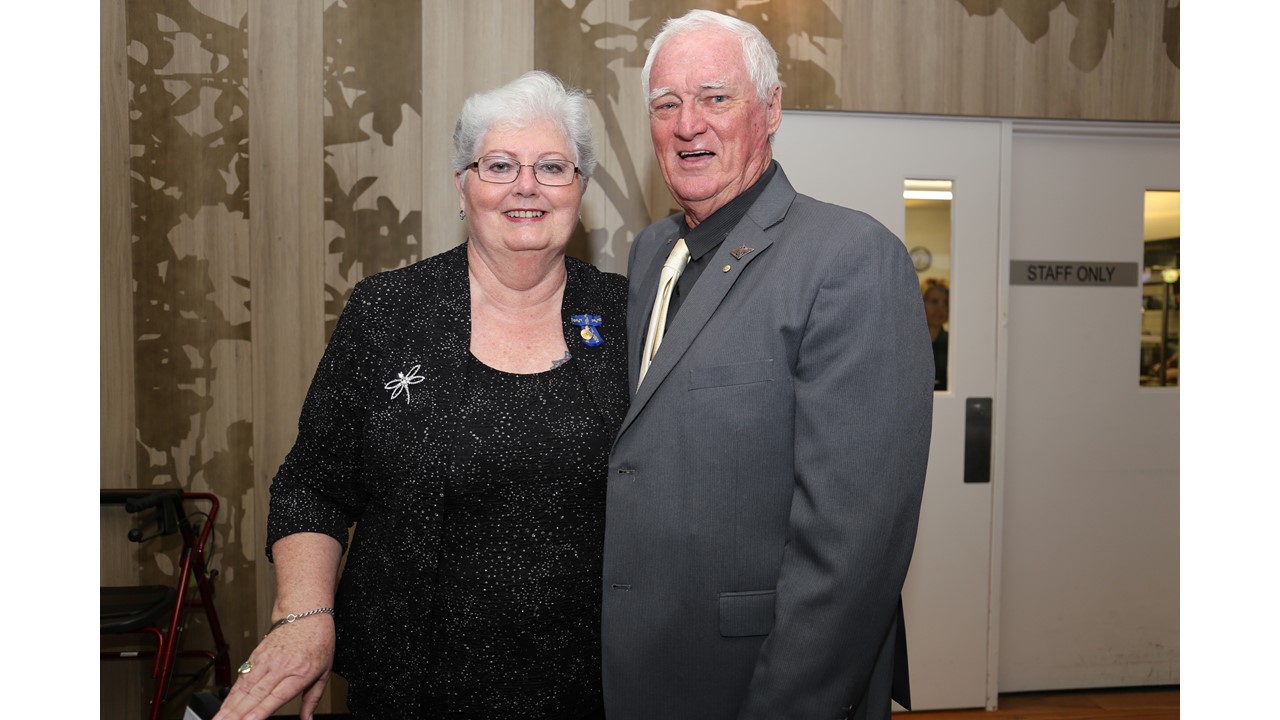
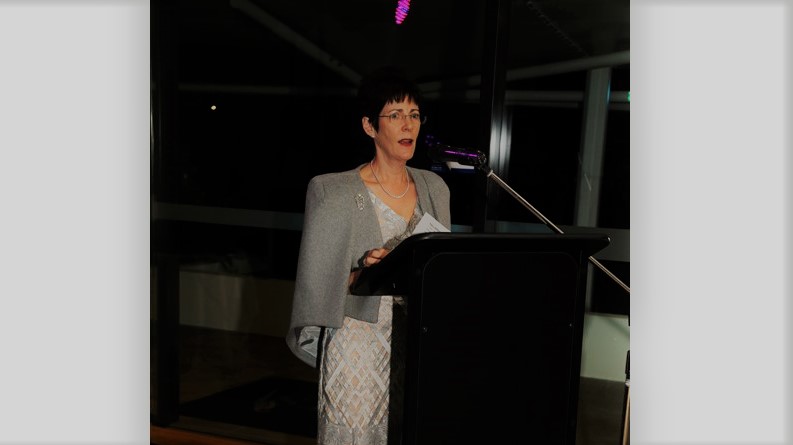
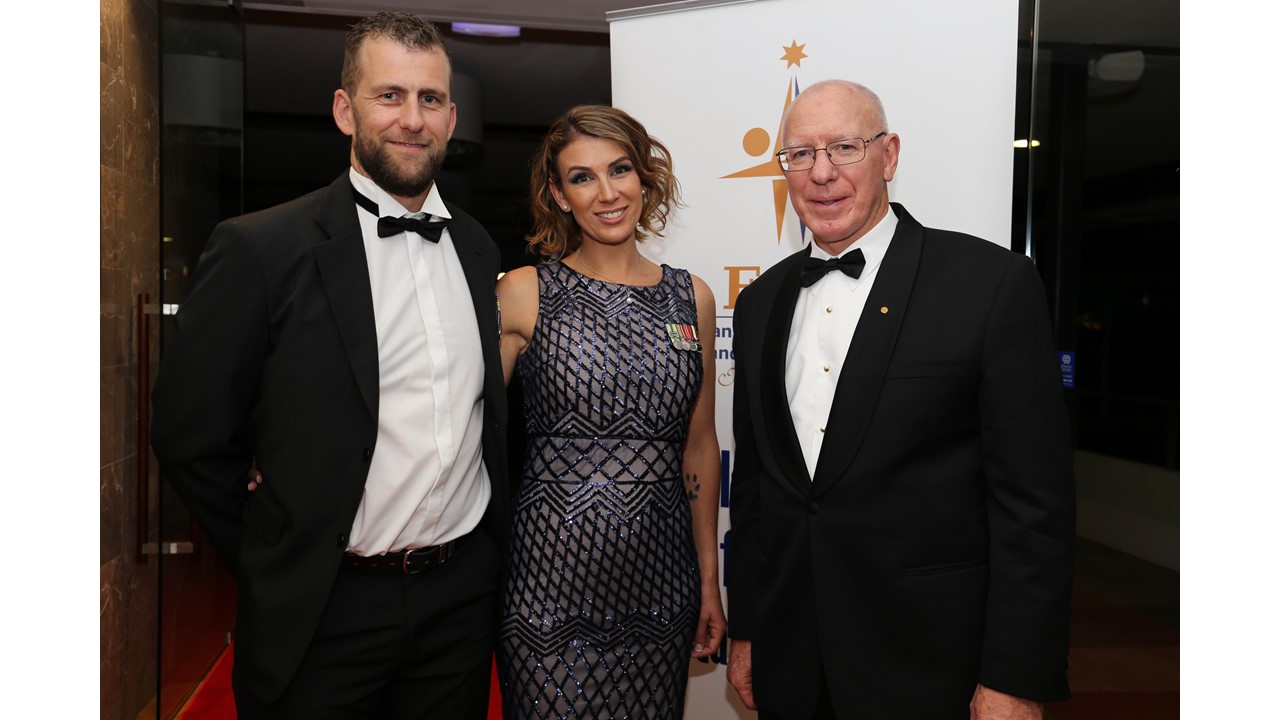
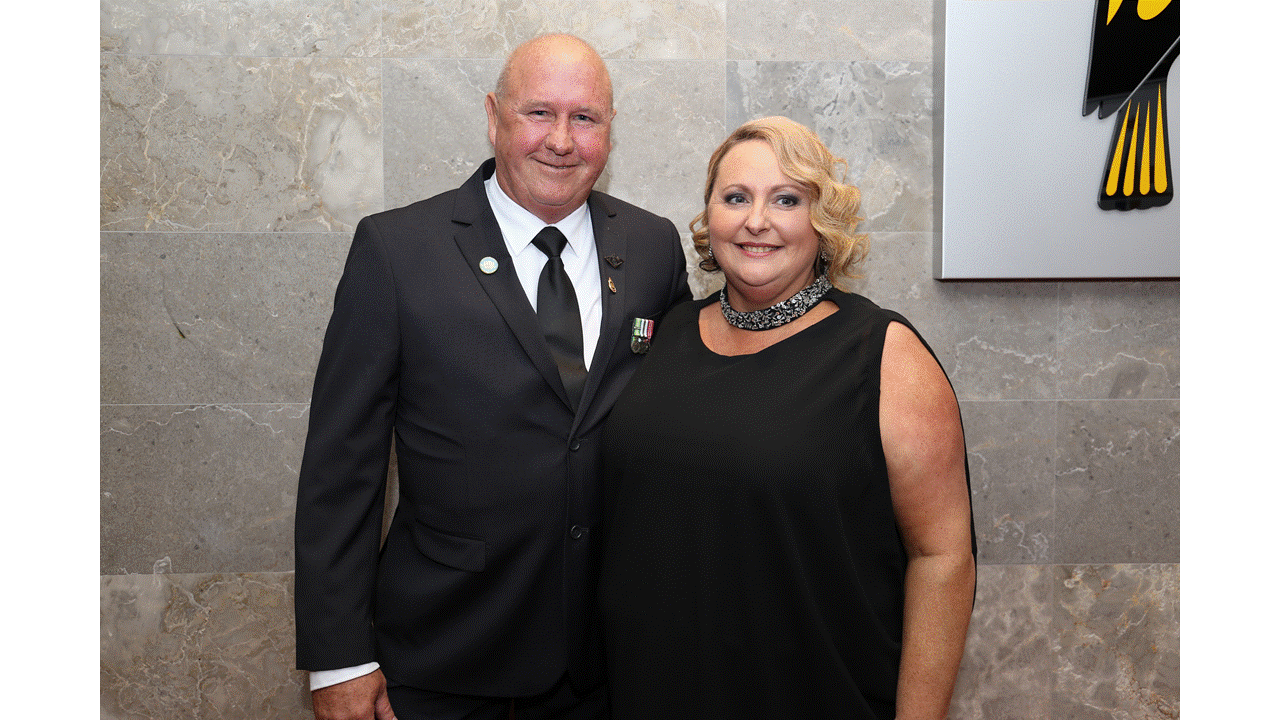
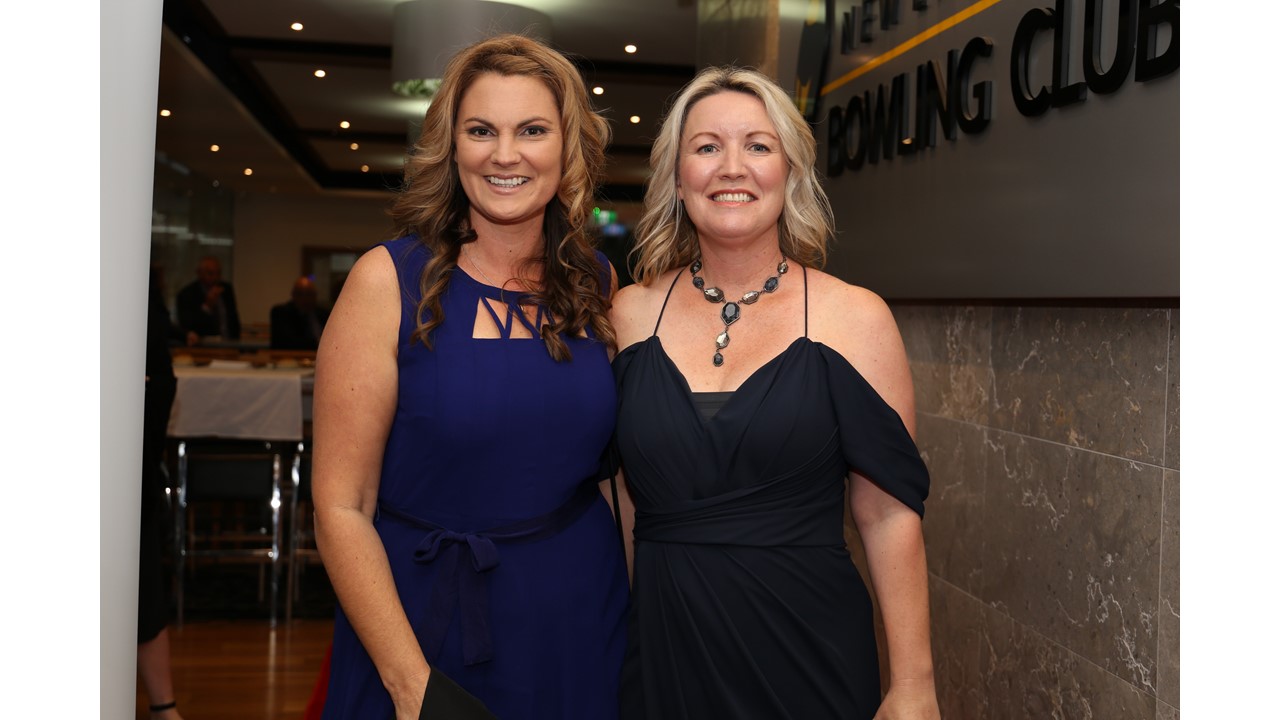
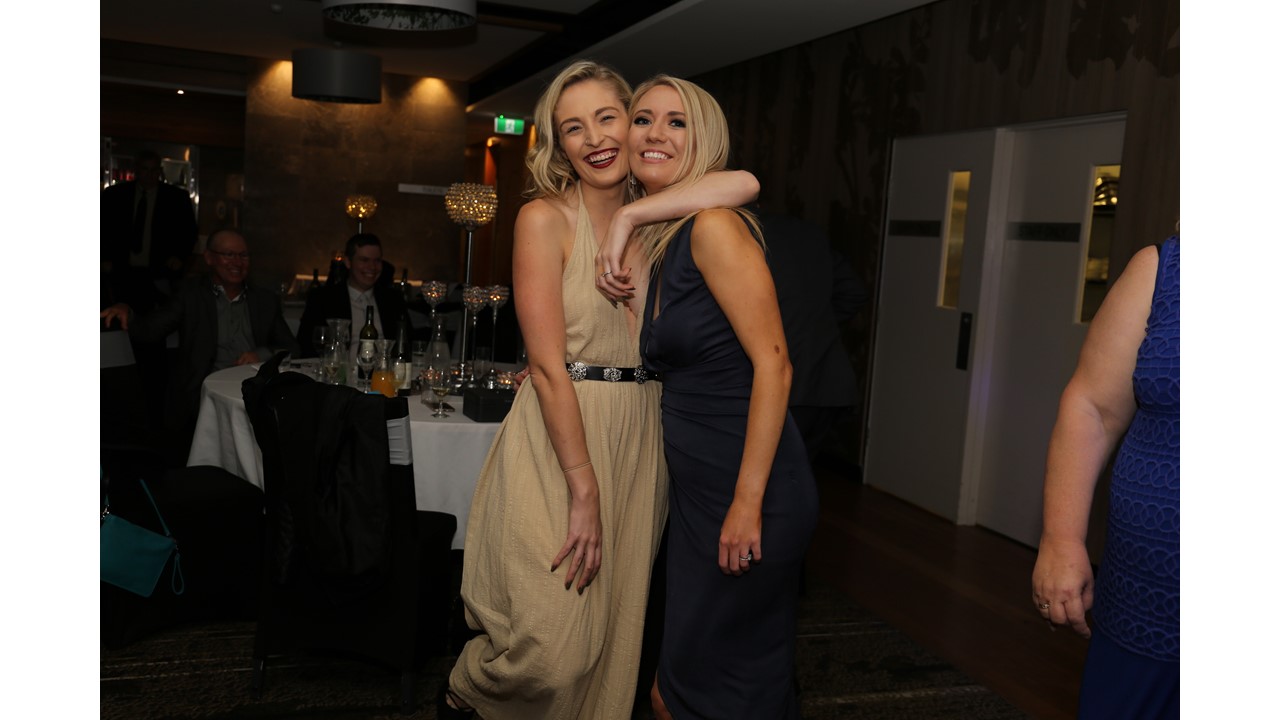
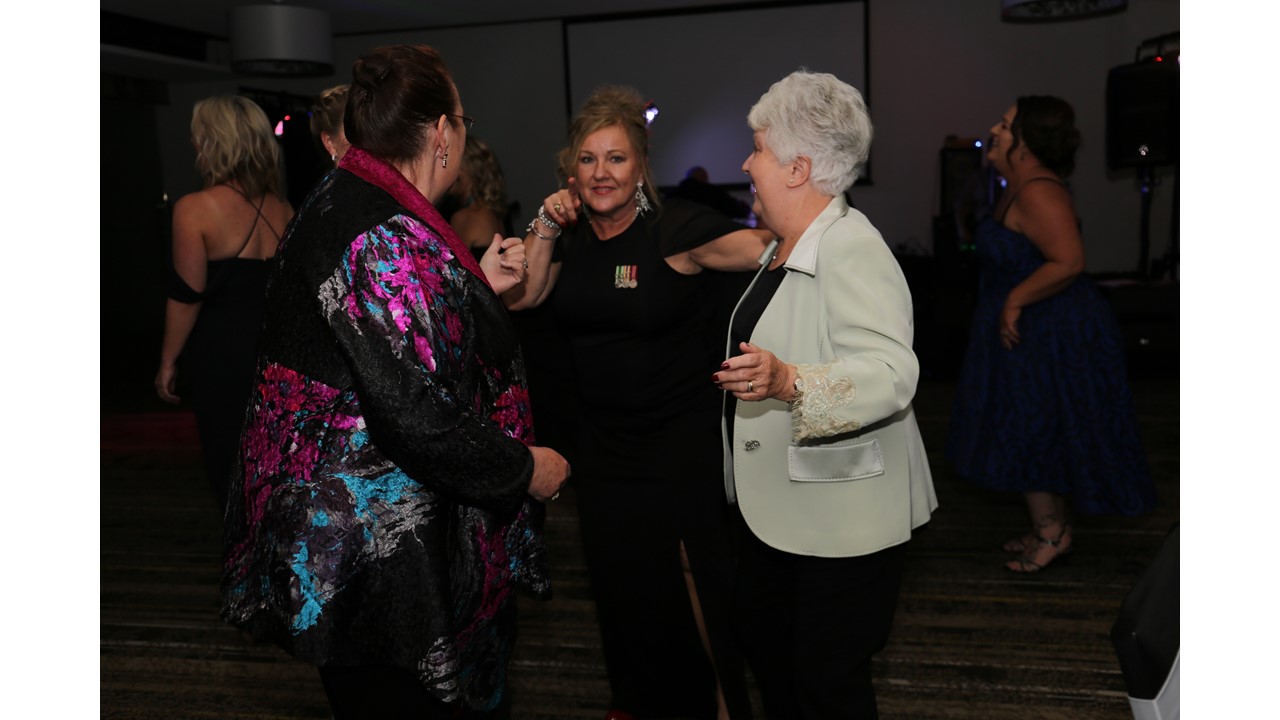
RETREATS
For dates and more information on Boot Hill Retreats (just for the felllows at present) please contact John Bettley on This email address is being protected from spambots. You need JavaScript enabled to view it.
This year we are trialling collaborations with Operation PTSD Support for our Ladies retreat. for more information on that see Womens retreat 2018 If you need assistance with transport call Donna or contact us here at AFOM. It is looking like it will be a spectacular time and a great getaway.

Another one is available further north in Townsville - more information at Ladies retreat Townsville in August
CHRISTMAS CARE PACKAGES
It was fantastic to receive feedback regardnig our parcels for Christmas for the troops. A big effort for all involved, a massive effort for Belinda Woods!

FUTURE PLANS
Along with our normal phone calls, web enquiries and emails, we have had more calls to address homeless and psychological fragile veterans over the past few weeks. These have been handled very well by our small team. However, we have found out that a lot of services that advertise "services" do not actually apply to these people we are trying to help. We are extremely happy to have a Masters in Social Work student (whose passion is working in this field) now on placement with AFOM (more background work done over the past few months!). One of the tasks for her is to put those services who can help into a flow chart of sorts so those AFOM members trying to assist know how to contact those associations that can help and are not constantly turned down by those that can't. If you can genuinely assist Veterans and/or their families in crisis and would like to be on that database (where ever you are in Australia) please contact Wendy at This email address is being protected from spambots. You need JavaScript enabled to view it.
AFOM has recently commenced a service that complements that planning: Front and Centre Services. See more at
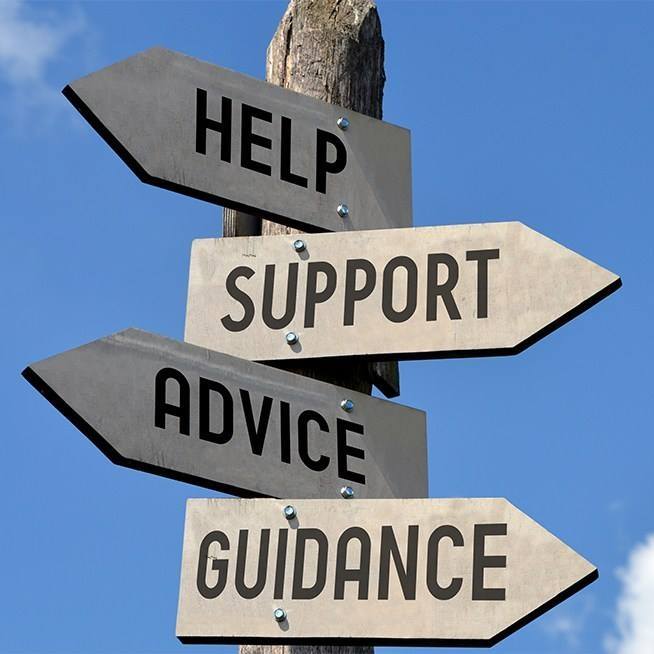
IN THE KNOW
Gail will be the inaugural Speaker at a new Mental Health Support group opening up - not only for those with Mental Health conditions, but also for those family and friends that help support those with mental health issues. In other words, working on the AFOM model - which will feel very excited about.
She will also be travelling over to Perth again this year for more Invisible Wounds Seminar/s. Thank you PVA WA:
Gail has also been busy this week with talks to Lions Club (Cessnock) and Masonic Lodge (District 15 Combined Lodges) who heard of our good works and the limited budget AFOM runs on (our funds go directly to Services for Military personnel, Veterans, First line responders and their families). We were all delighted to receive substantial cheques from both Community Groups to go towards AFOM's work. Both groups ran fundraising nights for AFOM. Thanks to John and Ann Bettley - who were able to attend on behalf of AFOM and to Wendy Waldrom who gave a speech on what AFOM does at the Masonic Lodge Fundraiser (St Patricks Night) and thanks to Ruth Rogers who discussed AFOM on the Fundraiser night given by Cessnock Lions.
A Huge thank you to Cessnock Lions and District 15 Masonic Lodges

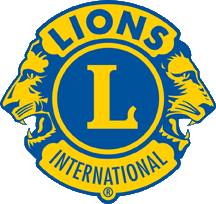
We still have quite a bit of work to do for the rest of the year, including a workshop on Mental Health in Adolecents and further exploring collaborators and sponsors for a Drop in Centre, that can also have outreach to more rural and remote areas (long term plan). If any one out there would like to help us in that area, feel free to contact us: This email address is being protected from spambots. You need JavaScript enabled to view it.
FUNDRAISING EVENTS
Our next Fundraiser is a bus trip to Vivid See Link for more details Vivid Trip
ANZAC DAY
With ANZAC day coming up please remember to take care of yourself and others. While we commemorate ANZAC day, many feel distressed and alone.
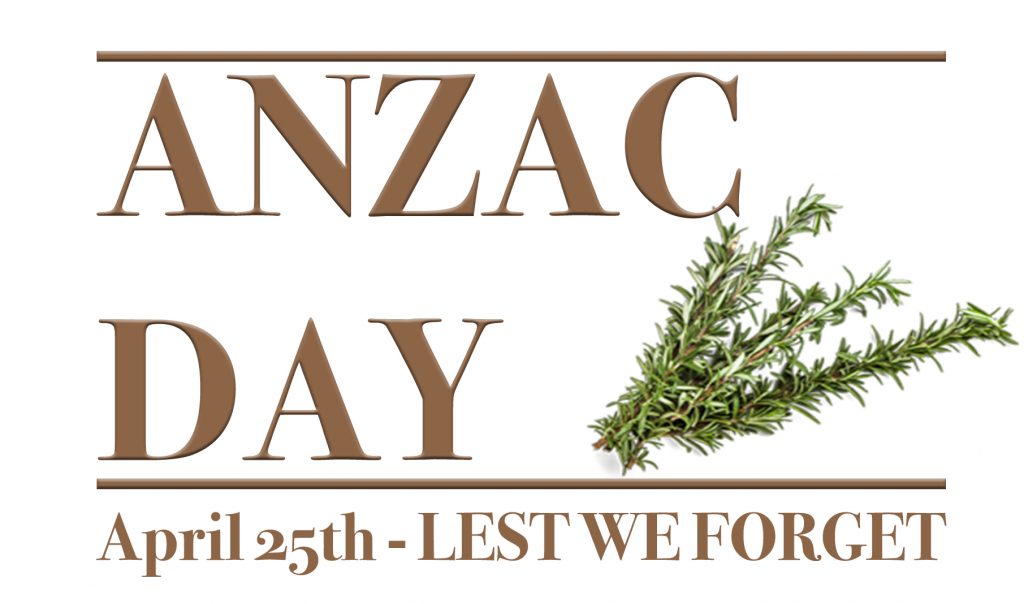
Crisis Telephone Counselling Services:
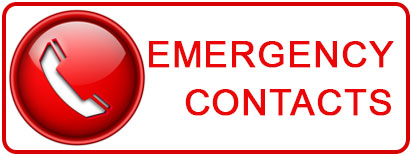
Lifeline: 13 11 14 - Anyone across Australia experiencing a personal crisis or thinking about suicide can contact Lifeline for support.
VVCS Call :1800 011 046
Kids Helpline: 1800 551 800 - Provides specialised help for young people aged 5 to 25 years, and is staffed by professional counsellors.
Suicide Call Back Service: 1300 659 467 - The Suicide Call Back Service provides crisis counselling to people at risk of suicide, carers for someone who is suicidal and those bereaved by suicide. People who are not linked in with current professional support can also access up to six sessions of ongoing counselling with the same counsellor at scheduled times.
MensLine Australia: 1300 78 99 78 - For men of any age who would like support, information or referral to assist them to deal with relationship problems in a practical and effective way.
Sexual assault, family and domestic violence Line: 1800 424 017 - For anyone in Australia who has experienced or is at risk of sexual assault, family or domestic violence and their non-offending supporters.
All of us at AFOM hope you had a wonderful, peaceful and safe Easter

Partners Retreat 2018

AFOM is delighted to collaborate with Operation PTSD Support Partners Forum for this years retreat !
This retreat commences on May 2nd for a week OR if you can only get away for the weekend (a long weekend) that may be able to be arranged as well - It will be at the beautiful Rainbow Beach.
All details below
A fun respite retreat for those partners that are caring for an incapacitated veteran.
Accomodation is shared ( Please book two shares for a single room and contact Donna on 0430166070 ) The cost for shared accommodation and activities will be no more than $300 for the five nights. ( less depending on fundraising success). Hopefully with fundraising we can reduce this significantly. The accomodation is very modern water front studio apartments at Rainbow Bay.
Activities have not yet been finalised but as always they will be entertaining and a lot of laughs.
No gaurantee can be made to find you a room buddy, it is much easier if you organise this yourself.
Please notify OPPTSD Support of your details
include a scanned or photograph copy of proof of military service for your partner or self, this can be a copy of Gold / white card
Who you are sharing with.
To, This email address is being protected from spambots. You need JavaScript enabled to view it.
There are limited rooms so best to book in early. The deposit is non refundable. Final Payment will have to be made 6/4/2018 and an invoice will be emailed to you for this.
If you can just come for the weekend ( its the long weekend) let me know and we may be able to buddy you up with someone able to spend five nights.
There are cooking facilities in each room, however we will also be having some meals ( bbq) provided.
Please contact Donna on 0430166070 for further information.
Charity Dinner and Fundraiser
AUSTRALIAN FAMILIES OF THE MILITARY RESEARCH FOUNDATION (AFOM)
AFOM researches and provides supports service for the families of the men and women of the
Australian Defence Forces
THE FREEMASONS OF DISTRICT 15 ARE HOSTING A
“ST PATRICKS DAY” WARM UP CHARITY DINNER AND AUCTION NIGHT 
WHEN: SATURDAY 3RD
MARCH 2018
WHERE: CLUB MAITLAND CITY IN THE DIAMOND ROOM
TIME: 5:30PM FOR 6:00PM
DRESS: SMART CASUAL WITH A CELTIC THEME OPTIONAL
COST PER PERSON : $45.00

The price includes a 2 course dinner, prepared by the Club resident Chef..
Sparkling wine will be served with “nibblies” on arrival.
Complimentary Tea and coffee will be available.
Alcohol beverages may be purchased at the bar at normal club prices
Entertainment will be provided by the
“RUSTY HARPER CELTIC BAND”
ALL MONEYS RAISED FROM THE DINNER AND AUCTION WILL BE DONATED TO AFOM
COME TO THE DINNER AND HAVE A MOST ENJOYABLE NIGHT AMONG FRIENDS AND AT
THE SAME TIME SUPPORT A MOST WORTHY AND WONDERFUL CAUSE
Tickets can be purchased by cash, cheque or direct debit to BSB 637000 Account 723352835
using your surname and initial as reference, pre payment is essential for catering purposes.
To purchase tickets or to sponsor the evening, please contact:
Mark Pollard on 0419 401 372 or by email This email address is being protected from spambots. You need JavaScript enabled to view it.
or any District 15 Lodge Secretary
For information on AFOM please refer to their website www.afom.org.au
Forgetfulness and Aging: What's Normal?
Keep Calm and ... How’s That Go Again?
Odds are, you won’t be as flexible at age 60 as you were at 20. Or as fast. Or strong. Time affects your body, and your brain comes right along for the ride. Connections between brain cells that make and pull up memories change as we age. And the proteins and hormones that do upkeep in our brains don’t work as well. As we get older, it’s good to know the difference between typical forgetfulness and something you probably should mention to your doctor.
SES Veterans Group
At last month's AGM our new Director Raechel Squires spoke of how initiated a new veterans' support group within the SES
Congratulations Raechel and SES.
https://www.youtube.com/watch?v=3yT8aid6Pyw&feature=youtu.be
Men's Retreat No 7

Next Men's Retreat/Working Bee
6th December - 10th December 2017
Meet at Mortel's at 10am or Dungog IGA at 12:30pm
Meals provided, Tea, Coffee and Soft Drinks
Cost - $60-$70 per person (depending on numbers)
RSVP to John (0404 836 765) by Friday 1st December for catering purposes.
AFOM's gifts for our Australian Troops
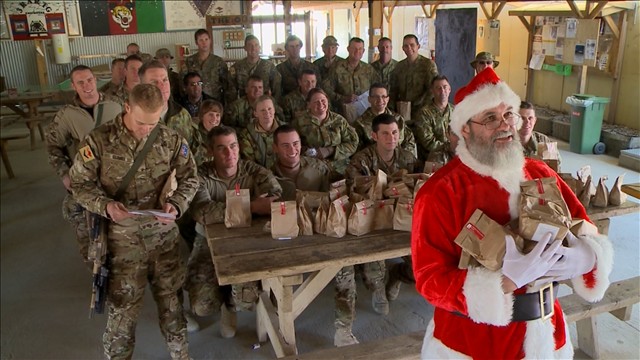
AFOM is using money raised this year to put together packages to send to our troops overseas.
If you would like to be a part of this, feel free to donate money or suitable items such as those below.
For more information Ring Belinda on 0438 577 518 or Ann on 0404 809 695 or Emma on 0423 614 261 or Gail on 0412 322 756 for drop off points or simply use our website or email This email address is being protected from spambots. You need JavaScript enabled to view it.
We hope to have the packages ready to be sent on or around December 1.

Food • Anzac biscuits • Salted peanuts • Muesli bars • Instant Noodles • Lollies • Small tinned consumables • Other commercially manufactured and packaged foods that are non-perishable Toiletries • Deodorant (non aerosol) • Shaving cream (non aerosol) • Small bottle of talcum powder • Disposable razors • Shower Gel • Lip Balm Other ideas • Magazines – eg Vogue and Women’s Weekly to Men’s Health and Wheels • Puzzle books • DVDs • Socks • Letters of support • Posters and letters from school children • Stamped, self-addressed envelope – this way personnel can thank you for the package
What AFOM has achieved over the last 12 months.
A wonderful time was had by all at our Black Tie Red Carpet Dinner.
The food was fantastic, there were lots of prizes and of course the people there were marvellous.
The highlight of the night was when our Ambassador Mrs Linda Hurley, gave a wonderful speech and then sung a beautiful song that she composed and wrote for AFOM. There were not many dry eyes at that moment. Mrs Hurely is truly an inspirational Lady.
For photos of the evening, follow the lionk below.
https://www.facebook.com/pg/AFOMRF/photos/?tab=album&album_id=1527409424008697
We would like to give you a quick overview of what AFOM is doing, firstly what we have done and achieved in the previous 12 months and what we are planning for the next 12 months or so and why.
However, I would like to point out what we don’t do first. We try as much as possible not to replicate what other ex-service organisations are doing, while there may be overlap in some cases – we refer on. For example, we do not do pensions, we do not do one on one professional counselling, we do not fundraise to send people overseas. We work mostly at grass roots levels and address the gaps we find in services.
In the last 12 months: We do make representation to Government and the appropriate departments and have made contributions to many mental health enquiries both to Government, Senate enquiries and other bodies e.g. Mental Health Commission
We have had men’s retreat, thanks to John’s organising and of course masterful cooking! These retreats have started to become the norm, where the men are champing at the bit to go back to the mountain. So much so they have been building small builds, shelters and other out buildings to make their lives more comfortable. They have now named their retreats as “Boot Hill Veterans Retreat” it has a GP boot as their logo. Anyone want to go to the men’s retreat? See John.
We have had lady’s retreats. The last one included two current serving Military ladies. I wasn’t sure how the mix would be, but all was fine. The ladies from previous retreats have now become peer support people to each other (great friendships have been made) as well as for others. For example, _ I get messages via our webpage for help, when they are in this area, I can put them in contact with either support groups, relevant ESOs or for those who just need someone to talk to, there is myself, but now also the younger partners. We are really trying to have another one next year, as I have already had enquiries from some of the younger partners about coming. There is lots of good wine, nibbles and of course the massages.
Lindsay and John run the Red Friday Coffee meetings, where those people can come and go each Friday have a chat, help and support each other or just have a coffee.
We have run Invisible Wounds workshops and from that (feedback) we are planning an Adolescent Mental Health Workshop in the New Year. – I have some great speakers/educators lined up – and they like us are doing it for free.
We are slowly growing with the research Program we have with the University of New England, and we even had enquiries on collaborating with researchers from overseas. Academia is a slow process.
We have FINALLY gone through the hoops of setting up a research prize for young post grad students who want to research in trauma, mental health including PTSD families and surrounding topics.
We have been inspired by a young filmmaker and had a short film made about us.
We have had another paper published about the well-being of partners of veterans, which led to press releases in several states and radio interviews.
Gail has been a general and key note speaker based AFOM’s research and work.
We represent AFOM at Ceremonies, ANZAC day and were very pleased to receive an official invitation to be at the dedication of the Australian Peacekeeping Memorial last month.
We feel we have achieved a lot in the last 12 months. We are a small band of people who are passionate about the health and well-being of families of the Military as well as front line responders. We are all volunteers and juggle these projects between work, family and the day to day issues of managing mental health issues in our families. We receive no financial benefit, in fact we pay for most of the costs and travelling from our pocket. All our board members are either current or ex serving Military or members of their family.
We have Bunnings BBQ’s to raise money to run the retreats and workshops – so we can offer Military families time out without costing too much. We then then nights like this to raise money to carry on.
We collaborate and refer on where we can, and where we can’t - we fill in the gaps.
The next stage of our plan: is to address another gap we have found. More recent research, here and overseas, talks about the families and the importance of looking after them and how the departments might engage in them more.
Despite millions of Dollars being spent on different programs and research the suicide rate from Military Veterans keeps rising. No data is kept on the suicidality of partners of veterans, however, when it was bought to their attention again -it was recently promised, so fingers crossed for that.
The Australian Institute of Health and Welfare talks about how our lives may be shaped: We all bear the imprint of our past, our experiences in early childhood are central to how we feel, think and behave as adults and contribute to the shaping of our emotions, preferences and choices. No amount of research can delineate the paths individuals will follow through their lifetime – but what we can do is clarify the forces and themes that lead many people in similar directions and help shape their lives. This leads overall to a greater understanding of others and life.
What do we know?
– We know that children of Vietnam Veterans (In Australia) are 300% more likely to attempt suicide. There has not been much research done on post 75 Australian conflicts and children of those personnel that serve. However, we could deduct that there may be problems down the track, given previous Australian research and current overseas research.
We know that there is a higher rate of suicide (13% higher) for men who have left the forces? Remaining in the Military, and Good leadership is a protective factor for many.
With Leaders such as Lt Col Morris (attending the Black Tie Dinner) , we can understand that, the excellent leadership qualities count for a lot.
Research has shown (overseas) that the highest single factor of Peacekeepers and Peacemakers who suicided or attempted suicide was relationship break up – this was a study that looked at 22,275 peacekeepers who served on “International Operations. Where they found that stressors from service could have contributed to suicide they stated: it cannot be excluded that stress reactions following peacekeeping may have contributed to possible strains on interpersonal relationships. Preventative work should, preferably provide psychosocial support for veterans and their families.
So, we can moan and groan, we can blame government departments and other institutions, or we can do something.
In line with all of that and AFOMs commitment to filling the gaps and to trial a model that we have developed I have been collaborating with local people in the Singleton Hunter area, who are as passionate about these issues as we are. So, our plan for the next few years is to establish a veterans and family resource centre. This will also encompass first line responders.
There will be 3 arms. Firstly - Education – we believe that education on a community level is the best way to approach mental health (In fact one of our goals is to make is to make the area we are working in the Mental Health Literacy Capital of NSW if not Australia – we do aim big). This also helps to reduce stigma and the beneficial flow on effects of that.
Secondly: Act as a resource directory to all available services (and again to identify any gaps) and thirdly to have a one stop shop – so to speak. This will have all the relevant ESO’s with expert people who attend to pensions and allowances, for current and past serving, war widows and not have people being sent from one place to the other. We hope to have this as a drop-in centre as well.
We are currently working on strategies based on what we know for giving new families to the area, more accessibility and knowledge. Combined with other organisations we want to offer more support and hopefully catch a lot of the partner/families that find it hard to participate in a new environment.
We have a handful of committed people already and we are waiting for discussions with other organisations in the area, to make this a reality. There is a lot more to discuss – but that is not for tonight. If you would like to know more see me (after the food). You may wish to be on board or assist in other ways – all genuine help is appreciated.
We can’t help and save everyone, but we can do our best and hopefully show what can work if a community pulls together, on these issues.
So, thank you to everyone, who have supported us over the previous 12 months - we really do appreciate it.


